Numeracy in Nature Blog
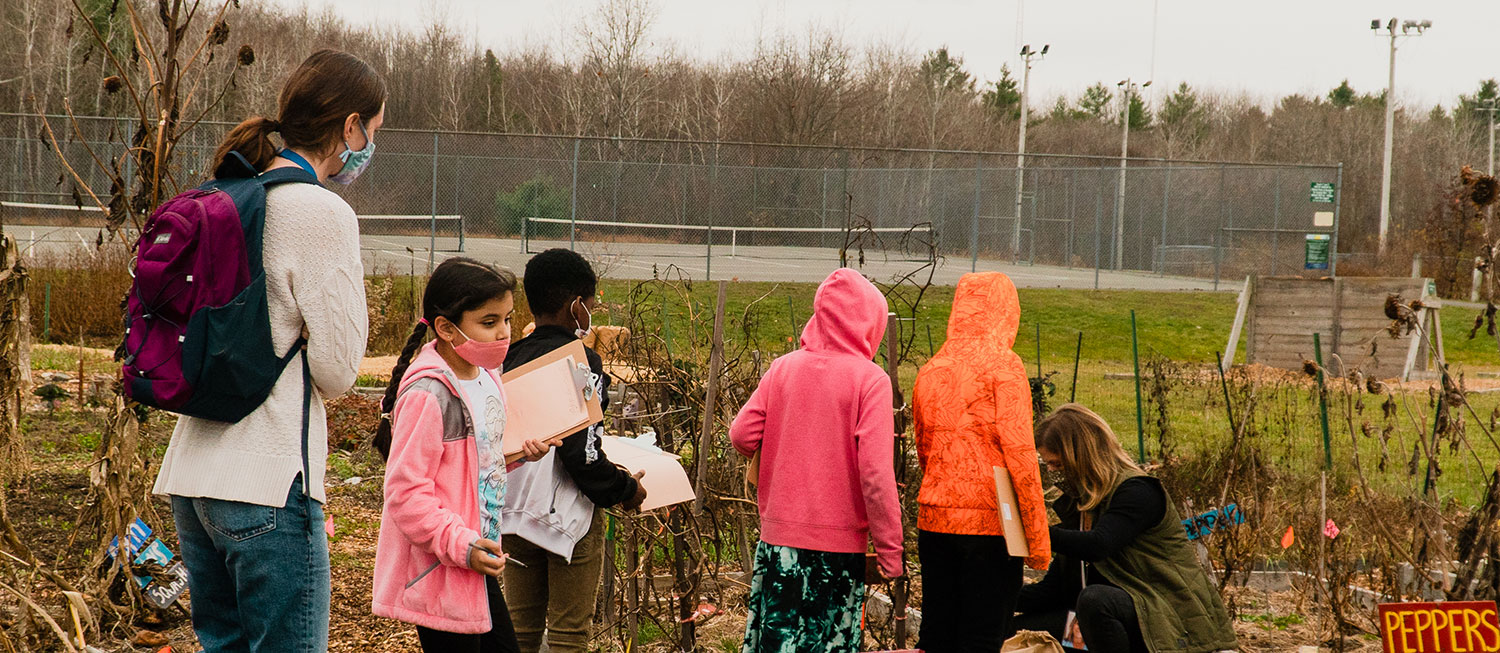
How Many Sticks?
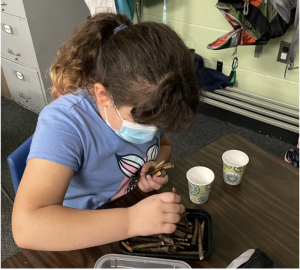
Teaching in the outdoors in Western Maine often has it challenges when it comes to inclement weather. Though we try to go outside in both good weather and bad weather, sometimes it is simply just too wet or too cold. This is often a nearly devastating moment for our students as they look forward to going to the woods so much!
One of my biggest goals this year was to incorporate nature in my students learning more and more! Ideally, that would be done outside, but when it can’t be done outside, we bring it inside! So, when we were recently faced with some bad weather on a day that we were supposed to go to the woods, we brought the woods into our classroom!
We had previously done an activity in the woods where students were asked to fill a provided container with as many sticks as they could. This lesson engaged students in the idea of space and measurement. We had happened to finish that activity in the classroom and I had on a whim saved all the sticks for a rainy day!
In math we just so happen to be learning about efficient counting strategies for large collections. This work focuses on hundreds, tens, and ones. Students were tasked with finding out how many sticks there were in all! Small groups were given random amounts of sticks and they worked together to find out how many groups of ten and how many ones they had. From there groups combined and then turned their groups of tens into groups of hundred!
Students were so engaged in this hands on activity that allowed them dive deep into the concepts of place value and counting! It wasn’t quite the same as going outside, but all my students were so excited to still be working with natural objects. I heard excited statements like “I can’t believe Ms. Virgin is letting us have all these sticks in the classroom!!” and “If there is THAT many sticks here, I wonder how many there are in our whole outdoor classroom…”
Whether inside or outside learning with nature continues to be the best way to engage my learners!
Kaitlyn Virgin, Meroby Elementary School, Second Grade Teacher
Brr It’s Cold Outside!

During the cold winter months, my students frequently ask, “Ms. Virgin, are we going outside today?” This week they had heavy hearts when the answer was no. Next came, “If the animals can be outside, how come we can’t?”
This was the start of a beautiful learning moment….
We stayed inside and watched a super interesting movie on animals in the Arctic. We had been studying Jan Brett books, and the students were really interested in learning about the cold environment. Then we talked about animals in the arctic and how they adapt. This led to a discussion about how not all animals adapt; some migrate and others hibernate. We then learned that animals have thick fur, oily coats, and blubber- we humans don’t, and this is why they get to be out in the cold!
As a fun activity, students used rulers to measure the height and length of animals that live in the arctic. Next week we will learn about blubber and see for ourselves how it keeps animals warm. Don’t let the weather get you down!
Kelcie Virgin, Meroby Elementary School, 2nd Grade Teacher
Looking for Patterns
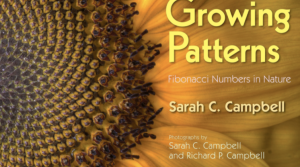
One of the activities that was presented in our Numeracy in Nature course sparked an idea to make a connection to one of the books I enjoy sharing with my middle school students “Growing Patterns” by Sarah C. Campbell.
We started class by using a Google Jamboard to sort photos of flowers into categories. Students were given time to sort all of the images and then shared their thoughts with the class. Some students sorted by color, others by shape of petals and a majority sorted by number of petals. After time to reflect as a class I then read “Growing Patterns” to the class and we discussed the Fibonacci sequence. Students had great questions about other flowers that reflect the Fibonnaci sequence as well as the size and arrangement of the photos in the book which they noticed reflected the Fibonacci spiral. Once the students were confident in their understanding of the Fibonacci sequence they found their own examples of each number and continued the sequence on their own slide of the Jamboard. We then went outside to view the spirals in the sunflowers growing in our school garden. Students were able to see real-life examples of two different spiral patterns in the seeds of the sunflower.
Middle school students were engaged and interested to find more examples of the Fibonacci Sequence in nature. I look forward to continuing to explore Numeracy in Nature at the middle school level.
Amanda Bowen, Kingfield Elementary School, Grades 5-8
Shapes & Sticks
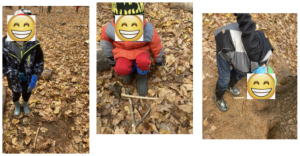
For the month of October our focus with our calendar was shapes. We worked on identifying circles, triangles, rectangles and squares. We also introduced 3D shapes. This week when we went into the woods, I thought about ways I could bring our learning about shapes outdoors with us. I started to think about the interest of my students and access to natural materials outside and it was easy: sticks!
Kindergarten LOVES sticks. I had my students collect 5-10 sticks each, while following our stick rule (No carrying sticks longer then your arm without a buddy!) The students happily collected their sticks and then we gathered in the outdoor classroom.
I took the sticks I had collected and began to create a shape around me with the sticks. I asked the students “What do you notice?”
“A triangle!”
“It’s a big triangle!”
I asked one of my students “How do you know it’s a triangle?
“Because it has 3 sides. 1 – 2 – 3!”
At this point, my students were eagerly awaiting to utilize their sticks. I was hesitant to let them explore without more direction, but I decided to let them go and show me what they know about creating shapes in a more open-ended environment. These are the results!
These are a few of the shapes that were made by the students: a triangle, square and what one student called a “prism.” We also attempted a hexagon, a cube and more triangles (those seem to be a favorite). This lesson transformed the students’ thinking into using materials around them to show their learning in a way that is meaningful to them.
Megan Lewia, Meroby Elementary School, Kindergarten
Shapes in the Snow
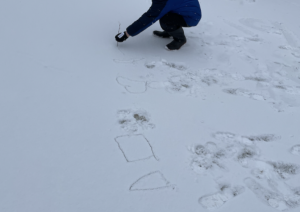
“It’s snowing!”
There are absolutely no more exciting words that you will ever hear coming from a child! This week when we were heading out into the woods we were gifted our first coat of fresh white snow. The beautiful sight caused a little snafu in our original woods day plan but provided us with an opportunity to do a quick review of our shapes!
While we were waiting for our first grade friends from the other classrooms we each took turns drawing and naming different shapes. I found a small shape drawing stick and asked the first student to draw a circle, “easy!” he said. Then I asked him to name another shape and ask his next friend to draw it. Each student had to draw one shape and name one not drawn yet. This was a quick opportunity for me to informally assess their shape knowledge!
Kati Mazza, First Grade, Meroby Elementary School
Patterns in Nature

Math in the woods? How can that happen? Nature can help us do math? What does being outside have to do with math? These questions were just a few out of the mouths of 1st graders at the beginning of the year. These questions have evolved into look at these leaves, they make a pattern! Wow! Look at that log, I bet it would take at least 50 pinecones to get from one end to the other. You found 5 worms and I found 2. I need 3 more to catch up to you! My students went from wondering how we could find and do math in nature to doing it naturally and recognizing that they are using their math skills outside of the classroom. Real world, connections have opened a new door of learning for them.
After a discussion about all the math we have learned and math that we have seen in nature we brainstormed about other things we can do. We talked about patterns and how we can use nature to make different patterns. Children came up with color patterns, shape patterns, different object patterns, and so much more out in the woods. They worked in partners to create a pattern with nature and to see if other groups could continue their pattern. We had so many great patterns and so much team work that went into collecting and making simple and more complex patterns.
As we wrapped up the activity, I dismissed the kids for free play before we go back to the building. To my surprise the kids continued to collect and make patterns on their own. Their awareness to math in nature has grown tremendously and so has their love for math. After I noticed a group of students still doing patterns, one of them said it perfectly, I didn’t know I actually like math!
Karri Hall, Meroby Elementary, Grade 1
Compost that Strategy
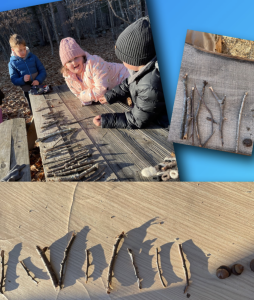
There is something about counting that feels good. It’s rhythmic, it’s fun, and it’s a well-practiced skill. When given a set of objects like a box of chocolates or silverware, even adults resort to counting one by one. It works…until it doesn’t. Second graders solve problems with 2 and 3-digit numbers, thus requiring them to use more efficient strategies. For example, if faced with a problem requiring students to find the sum of 34 and 23, students do not want to count from 1 to 57. However, they may still need to “see” the amounts before they are ready to use the symbols.
My students had seen models of 10s and 1s as part of our daily tally of the days in school. The model consists of 10s sticks (made up of 10 small squares) and ones (single squares). However, they had not created their own representations. I asked them to think about how they could use nature to show 5. Hands shot up and they talked about using leaves, acorns, rocks, pinecones, and small sticks. Then I asked them how they could show 10. Many thought to just add 5 more to the 5 they already had. One student said, “We could do like we do in the morning and use 10s and 1s. We could break branches to make sticks. They can be our 10s.” I could see the lightbulbs turn on, as others were nodding in agreement. One child said, “That will be much more efficient.” They decided to use sticks and acorns because they are plentiful. They also thought it would be more accurate if everyone used the same materials.
So, off we went to the outdoor classroom. After sprinting to the woods and gathering bits of nature on the ground, the students used their 10s and 1s to make 2-digit numbers. After successfully representing a few numbers, I asked them to challenge themselves to solve a math problem with the materials. I had to hold back from just presenting them with a problem. I was willing to trust that they had ideas that may not only be more motivating, but more diverse and challenging as well. They did not disappoint.
One child showed 9 sticks and 3 acorns and explained that it would take 7 more acorns to make 100. I asked how many would need to be subtracted from the 93 to be left with 50. At first, the answer was 40, then it changed to 43. A pair of students were working to figure out the sum of 1st and 2nd graders. They had to add 13 and 19. They thought to make one stick and 3 acorns and another stick and 9 acorns, but then they included a plus and equal sign. I asked what would happen if they left out the signs and combined the 10s together and the 1s together. You would have thought I had given them candy! They quickly combined the sticks and then the acorns and shouted, “32.” Someone came up with the idea of combining sticks and acorns and soon they were working in small groups representing in the 100s.
To finish the lesson, I asked their advice about the counting all strategy. What do you think we should do with that strategy? That’s when we decided it was time to let it go. We wrote, “counting all” on paper and literally dug a hole and buried it in the outdoor classroom.
Laura Waite, Otisfield Community School, Grade 2
Oak Leaves and Number Racks
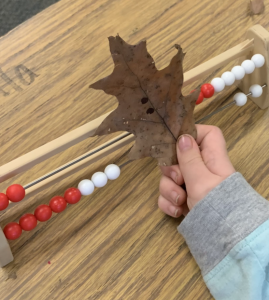
It was a rainy November day and I wanted to add some nature to liven up our indoors on this gloomy day. Thankfully I had squirreled away some oak leaves, perfect for some engaging building 10 practice!
I drew dots (in 10 frame formation) from 1-9 with sharpies on the oak leaves. Then I gave my students each a leaf and a number rack. On the top row, (after counting the dots) they showed the number on the leaf. On the bottom rack, they showed how many more beads were needed to make 10.
I discovered after a sad marker mishap, that oak leaves are the absolute best leaves for this project. The sharpie does not bleed through, they don’t curl, and are tough enough to be passed around to other students.
The kids found this to be challenging, but engaging. They asked if they could try this again and practice it until it became easy! It was amazing how frustration levels stayed minimal, some of the kids decided that they actually could do it and shared their tips with those around them! Amazing!!!
Maggie Corlett, Meroby Elementary, Kindergarten
Are We There Yet?

If there was one good thing to come out of the global pandemic, it was the growth of outdoor recreation as a way of life. Many families started hiking, and found it was a safe activity, and often a chance to socialize. One of the field trips classes have begun going on again are hikes, because the outdoor aspect of the activity makes it a good choice.
Math is always all around us, and new technology makes measuring distances so much easier. Everyone has a GPS in their pocket now, and apps help keep track of mileage, maps, distances, elevation, and pace. The apps available are incredible. There has never been such a great time for kids to really learn about distances with this hiking-app phenomenon.
Recently on a 4th grade field trip, I recorded our hike, and periodically showed students where we were on the map, and how far we had gone. They started to try to estimate when they had gone .1 of a mile, and check against the app I was using. I found this was pretty powerful, because they became more accurate each time they tried. The idea of distance became real.
Next time you are in the outdoors, try one of the apps out there. I use Strava, but there are many others. Share the maps and distances with your students, and think of all the ways this can compliment your other measurement lessons. Miles and Kilometers become much more real when experienced firsthand, and you won’t have to answer that dreaded question, “Are we there yet?” With the flash of a map, they will know and be able to predict how much longer the hike is.
Karen Wilson, Meroby Elementary School Math Coach
Numeracy in Nature: Let Me Count the ‘Whys’
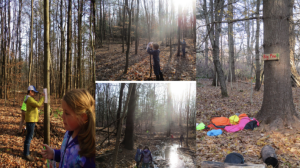
“Why?” is a question I hear often when discussing taking learning outside. I would like to share just a few of the many reasons I have learned from my experiences of taking math outside.
-
It is FUN! Yep, I said it. And who doesn’t like fun? And shouldn’t learning be joyful? Besides creating a positive learning environment, it leads to a waterfall of positive outcomes such as…
-
Engagement-when students are excited about learning, engagement follows. It is a rare occasion when one of my students does not look forward to math in nature. It is not unusual for them to brainstorm extensions for the work we are doing or completely new activities for the class to try.
-
It taps into children’s natural curiosity. We, as a species, are curious about the world around us. Put a child into a situation where they can explore and they are off.
-
Cooperation and conversations. When we are outside doing math, the students naturally move into what I call interactive mode. They want to show each other, problem-solve together, talk about what they are seeing or doing. Some students even move into teacher mode to help their peers. This addresses so many of the math practices we try to foster in the classroom. It is so much more powerful because it happens organically and we can help them hone their skills more easily.
-
Success-we all have students who struggle in the classroom for various reasons. Time and again, I have seen these students shine in the natural classroom. They feel positive about their learning, which leads to…
-
Increase in self-confidence. Taking learning outside seems to remove some of the fear of failure many students have when doing math. They focus on the experience, not a score. They take risks and are more apt to keep trying, they are excited to share their successes. I have seen students make intuitive leaps to higher concepts that they might otherwise struggle to make in the classroom.
-
Math is made real. Taking math into nature makes it real for students, not just something they have to do for school. They begin to see how math is an integral part of our lives and older students can see where concepts originated.
There are so many more benefits to ‘taking it outside’, but I think the best argument for it is that students love it. As learning is a life-long process, showing children that learning can be a joyful endeavor will pay endless dividends.
Even if math cannot be taken outside as often as one would like, using natural objects in the classroom can link to the excitement students felt when they were outside.
Cheryl-Lynne Finlay, Meroby Elementary, 4th grade
Mrs. Lewia’s Class: Math with Leaves

In the month of October, we have been using our surroundings and the world around us to help connect us to math in many different ways.
The first week when we noticed the leaves starting to fall, we made some information observations as we walked into the woods about the changes that were happening.
“they’re changing color.” “look at the red one, that’s new!” “why are they falling?” These are observations, connections and comparisons. Things we also include in math in the classroom setting.
The second week, when we went to the woods we went and collected leaves. We looked for all kinds of leaves on the ground. Here are some more comments I remember hearing.
“Look Mrs. Lewia! This leaf is bigger.“ “This leaf has some red and some orange.” “I found two leaves!” We made more connections, created more observations in the world around us, made comparisons of leaves on size, shape and color and I even heard some counting!
On the third week into the woods, I brought out some ten frame mats with us. My plan was to use the natural materials around us to show our understanding of numerals and quantities. As we gathered around our classroom in the woods after burning off some much needed energy, we sat down and first made observations of our blank ten frames.
I asked the students “What do you notice?” Some responses: “I see squares, and lines here and here and here.” “I see nothing, just white.” “It’s a big ten frame!”
I asked the students to collect a pile of leaves and put it next to them. Some students picked up a pile next to them, others were very peculiar about the leaves they chose. My goal was to observe their understanding of connecting numerals with quantities on their ten frames. While I was able to make some observations of their knowledge, I also noted the engagement. I noticed how excited they were to place the leaves they carefully picked out onto their ten frames. I noticed how they used the information they learned in the classroom and continue that learning by using materials around them. These students not only were connecting nature to math, but they were able to utilize social and emotional skills to work together collaboratively.
Megan Lewia, Meroby Elementary School, Kindergarten
Nature Splat
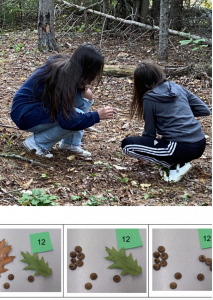
We started this school year with a focus on number sense and one of the ways that we did this was using Steve Wyboney’s Splats. Splats are a visual representation of numbers with part of the image covered. Students have to use number sense to find the missing information.
My middle school students made the connection to creating equations with the information provided in a Splat. We started with single step equations and moved to two-step equations. Students used variables to represent the missing quantities and were able to articulate how they solved the equations.
Once the students were confident in their ability to create and solve algebraic equations we decided to make our own Nature Splats. Students went outside to gather natural objects to use as manipulatives. We had a wide variety of objects from small rocks, leaves, acorns and even some students who wanted to use slugs! Students then created Nature Splats that showed a variety of single step and two-step equations. Students were expected to be able to create the visuals, write the corresponding equations and explain the steps necessary to solve for the variables. We created a collaborative Google Slide Document for students to share their slides.
Middle school students were more engaged with this standard when they were able to gather materials to create their own unique Nature Splat. I look forward to exploring more ways to combine Numeracy and Nature at the middle school level.
Amanda Bowen
Kingfield Elementary School, Grades 5-8
Bippity, Boppity.. Management!

Classroom management strategies is one of the most discussed topics by educators. We live it everyday, yet we are always searching for the ultimate technique that will work in every situation. The truth is, there’s no magic wand. There are too many variables inside and outside the classroom to have one easy fix, but isn’t that the beauty of teaching? The creativity, the imagination, the vision.
Here are some classroom management strategies that work in our outdoor classroom, that may work for you.
We have found that students work best when they are presented with a small activity for a short amount of time. Rotating them through twenty minute activities keeps them engaged for the time being, and wanting more when they leave. It also allows for students to build relationships beyond just their classroom teacher.
A favorite strategy of ours, is for lining up. We wanted to avoid using the whistle at recess, because Nature Exploration isn’t recess. Instead, we have a clapping method. The adult will initiate the clapping when it’s time for students to stop their activity and line up. The adult will give some type of rhythm to the clapping that students can follow. When students hear the clapping, they stop, and they start mimicking the clapping as they run to their home base. It works almost like a charm!
Kelcie Virgin
Meroby Elementary, 2nd Grade
Failure: An Opportunity to Learn

“Mathematicians, today we are going to pretend that we are surveyors! Do you know what a surveyor does? They use data and measurements to determine boundaries of a piece of land. We are going to gather our own data today within the boundaries of our outdoor classroom!”
What happens when you ask 40 second graders to look at a small cross section of trees in the woods, estimate how many trees there are, and then set them loose to count them within a small group?
Chaos happens, pure chaos. It was hard to see if students were actually meeting their learning target, and understanding the lesson as they were weaving in out of their peers and trees in the 20×20 foot grid space that had been created for them. As students were accidentally pushing into their peers and falling to the ground or accidentally messing up other groups’ counts by making a mark of the same color on a tree. As a teacher, it was feeling like a big ole’ fail!
However, within that chaos came a great deal of learning. This learning came from our students who practiced their estimation skills, calling on prior knowledge to help them create a reasonable estimation of how many trees were in the provided section. As well as worked on their communication, critical thinking, and problem solving skills to work together in a small group to then figure out exactly how many trees there were.
Learning also came from us as teachers. This was the first time we had implemented a lesson like this into our Nature Based Education Program. Prior to this lesson we had been doing rotations where smaller groups would rotate from one lesson to the next with a teacher at each station teaching a lesson. We decided to make this a whole group activity so that students could all work together and learn from one another. Though this definitely had it’s advantages it also had its disadvantages.
This activity was a lesson to us teachers that even though we took the classroom outdoors we can and still should implement similar management techniques such as, teaching the whole group and then splitting the whole group into smaller groups to perform the activity. Bringing the group back together as a whole to discuss. After this lesson teachers were given the opportunity to reflect and come up with strategies on how to better implement lessons like this in the future.
The outdoor classroom has taken us out of our comfort zones, metaphorically thrown us to the wolves, and had us running around totally overwhelmed. However, neither myself nor my students would change these moments for the world. In these moments we are taught the greatest lessons. The woods are messy, the woods are magical, the woods do not know failure, as failure is simply an opportunity to learn, maybe not what you intended to learn, but learn just the same.
Kaitlyn Virgin,
Meroby Elementary, Second Grade
Array Building
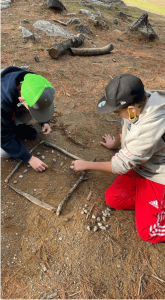
“Wait, we are going outside for math, and you don’t want us to bring anything with us?!”
Without any pre teaching I asked my students to put their materials down, grab their jackets, and meet me by the back door. As we entered the playground I instructed them to find natural objects (mass quantity) to help us build an array.
As they quickly collected materials I was amazed by their thought process while they worked together to build their first array. They were given the numbers 7 and 5 to use.
“Should we use these sticks to outline our array to make it more clear?”
“Do you want to set it up using 5×7 or 7×5?”
Working together the students created an array using rocks to show 7×5=35.
The students were then asked to design their own array. In order to show mastery they needed to show a different multiplication problem and try to find another natural object to display their array. The students excitedly ran through the woods and across the playground to find more objects to complete the task.
After reflecting on the process of building arrays and how we can use natural objects to learn math outside the students shared;
“Wow, who knew multiplication could be so fun”
“I love going outside, can we try to do this more!”
Still, weeks later the kids talk about building arrays outside using natural object and not paper and pencil with their peers and other staff.
Johanna Bartlett, Kingfield Elementary School, Special Education Teacher
Angling Around the Woods
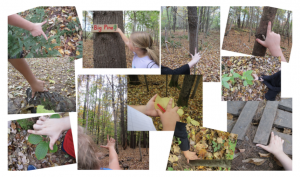
While learning about different kinds of angles, I had asked my students to find examples around the classroom. We then thought, ” Where else we might find them ‘in real-life’ ?” The obvious next step was to look outside.
I like to have students use non-standard measuring tools to estimate dimensions (something many of us have done in a pinch). So before we headed out, I posed the question, “If you do not have a protractor, what else might you use?” Your hand was one of the responses.
Students had already estimated that the angle made by their thumb and index finger was about 90º. We measured it with a protractor to see how close each student’s hand was, wrote it down and then headed into the woods.
Each student had a recording sheet with their hand angle measure on the top and a table for recording objects and their angle measures. They ran excitedly about the woods measuring things such as veins on leaves, branches on a tree , veins on a rock and boards on the bridge. A few brave souls tried measuring branches high above their heads and the angle formed by two tree trunks in the distance.
Initially, they began with just 90º and 45º angles, but then they wanted to measure whatever angle they could find. Thus we had a short problem-solving session on breaking 90 and 45 into smaller measures or adding onto the 90. It did not take the students long to fine-tune a process between themselves. Armed with this knowledge, off they went to try it.
Some students asked for a challenge, so I told them to look for objects that contained more than one angle, such as a leaf. Students used added and subtracted angle measurements to create acute, right, obtuse and straight angles. Once other students saw this happening, they began to challenge each other to find ways to create specific angle measurements. A bit of a scavenger hunt was created!
Once we had finished our activity, the students began to brainstorm other measurement activities we might do on our next trip into the woods. Math outside never fails to spark their imaginations.
Cheryl-Lynne Finlay,
Meroby Elementary, 4th grade
With Teamwork and Sticks!
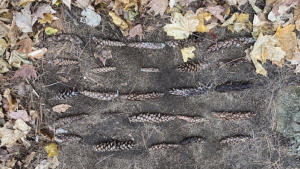
We have been learning about what arrays are and how to use them to represent multiplication equations. Last week, my class went into the woods to take on the challenge of creating arrays themselves with the help of the natural resources around them. Students worked in teams of two to use natural objects to create arrays that represented the equations 4×5 and 5×5.
Part of the challenge was for them to try to create it with their partner, and then show their array to either myself or another teacher. It brought me so much joy when my students ran up to me and proudly showed me the arrays they created. My students enjoyed the activity, and were excited to explain their thinking behind their arrays.
This challenge was fun and it brought out the creativity in my students. Some students used pinecones, some used leaves, and some used sticks. When I asked a team of students about their 5×5 array, one of them replied “We made it with teamwork and sticks!” and went on to say how creating their own array helped them better understand what an array is.
Jordan Glassock,
Meroby Elementary School, Grade 3
Building Arrays in Nature
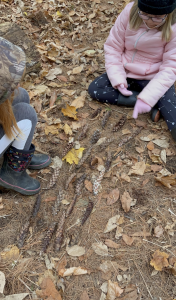
When learning about multiplication you have to understand the concept of equal groups. When you have equal groups it has the same number of items as all of the other groups.
In order for the students to understand what I meant, I had the students arrange themselves into equal groups. However, they could only have 2 people in a group. The students quickly realized there would be 5 groups of 2 because of the total number of students in class (10 in all). Next, I had them put the groups of 2 into columns and rows and asked the dimensions of their array and most of them said “It’s a 5 by 2!” or “It’s a 2 by 5!” I then took time to show them the difference on how the arrays look.
We all went into the woods and I asked them to collect natural objects (all the same) to build an array just like we did with ourselves. I didn’t tell them any specific instructions on how many items to get or even how to build the array based on the number of items they chose. In the end, they were able to explain to me about how they arranged their items into equal groups and why they chose to build that particular array.
It was amazing to see how many different arrays the students came up with after collecting their natural objects.
Alyssa Crews
Meroby Elementary School, Grade 3
Leaves and Ten Frames
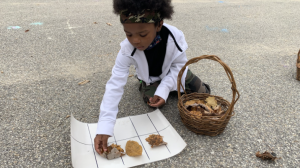
Kindergarten brought their collecting baskets to the woods, ready to embark on a nature adventure. The closer we got to our outdoor classroom, their excitement grew and grew. Once there, children moved freely around the forest, collecting small, medium, and large leaves of various colors and types. Children shared about their own leaf collections, and were naturally curious about what leaves their friends chose to collect.
“I see a hole in it!”
“The stem is so long!”
“I found a big red leaf!”
We took our leaf collections back to school, where we examined them closer and decided to use them as counters on large ten frames. Since we enjoy being outside, we carried our baskets and ten frames to the playground. While there, I wrote one number at a time on a white board, describing how to form the number while writing. Children shared with one another what the number was and then used their leaves to show how many.
We enjoyed this activity because it was outdoors and we got to use our own leaf collections! Creating a fun and meaningful hands on activity.
Jessica McMichael
Meroby Elementary School, Kindergarten
Rainy Day Math
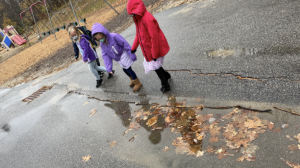
“The only way to learn math is to do math.” Paul Halmos
On a rainy Friday afternoon when you have been stuck inside for days, it is hard to hook your students into a lesson of any sort. What is a teacher to do! We haven’t had recess, no woods day, no fresh air inside the walls of our classroom.
This teacher decided it was a great time to teach her first graders about estimating! We looked out the window at a freshly created puddle and I asked them how many sticks they thought it would take to go the length of the puddle. The students all guessed an amount: “5!” “30!” “14!” We grabbed our jackets and out we went!
It took the kids less than one minute to collect 5 sticks each, and less than a minute (using great teamwork) to spread their sticks the length of the puddle. They took turns counting and WALAH! The puddle was 17 sticks long!
We loved this activity because it was outside, it was quick, and it taught us that doing math is a lot of fun!
Kati Mazza, Meroby Elementary School, Grade 1
Collecting for Fact Families
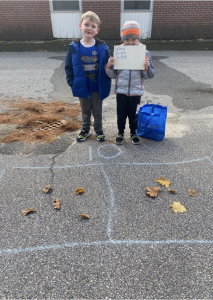
This week, first graders went to the woods with collecting on their mind. Sitting in the outdoor classroom in the crisp air students were asked to work in teams to gather natural objects that we could use as manipulative’s for math time. Some groups chose to collect leaves, some groups chose to collect sticks, and others collected items like pinecones and small rocks. The kids ran around with their bags and their group finding the best sticks and the best leaves to collect to use.
“WOW! Look how HUGE this leaf is.”
“I bet I have 100 sticks in my bag!”
“My bag has 3 different colors of leaves in it!”
Students talked to each other about their collections and were very curious about how we would be using these collections later during math.
Fast forward through the day to math time. Two of the first-grade classes met outside where there were 10 different “flap cards” drawn in chalk. Flap card and dominoes have been a topic in math for several weeks. All of the kids partnered up and were asked to use natural objects from their collections to make their own flap cards to match the whole number that was written above their flap card. This resembles a part-part whole mat. To take it to the next step partnerships worked together to write out the fact family that matched their creations on a white board. The level of student understanding for this lesson was amazing and the level of engagement shown was proof, in itself, that with a little fresh air and choice of manipulative’s students can succeed.
Karri Hall, Meroby Elementary, Grade 1
Measuring What’s Wild
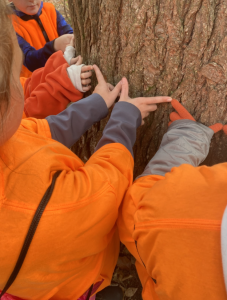
This week our 4th graders headed out into the woods at our Principal’s home to explore and learn about Maine’s natural environment. Seeing the kids outside was energizing. They came alive, running, hopping, and skipping. They wanted to inspect at everything!! They were fascinated with mushrooms and different tree varieties, and crossing a rushing brook was an epic adventure with shrieks of delight. The children definitely thrived in this new outdoor classroom.
“Whoa, look at that tree!!”
“Wow, it’s HUGE?”
“I’ve never seen a tree so big!!!”
“Why does it have red paint on it?”
Our Principal went on to explain that it was a property boundary tree, so the land around the tree had been logged, but they didn’t cut down this particular pine because it was a boundary marker between property lines. Seeing how curious the students were their teacher asked, “What do you think the diameter of that tree is? Can we estimate?”
Previously back in the woods at school, students had made estimates in the forest using their hand spans as a measure. They knew their spans were about a foot, so they could use that information to estimate how many feet long something was. Immediately they ran to the tree and tried to see how many of their hand spans it would take to go all the way around. They were short a small section, so the Principal joined them to close the gap. They discovered that it took the hand spans of 11 people to go around the tree, so the diameter was close to 11 feet!
The entire day was exciting, but this small connection of math with nature was one of many academic connections made that day. They measured their heart rates before and after their hike, and they tracked the number of steps they walked during the day. They also used a phone app to create a map of the hike and see how far the hike was. All of this math was done with inquisitive attitudes and smiles.
Yes, you can lead your students across water, and you can get make them think!
Karen Wilson, Meroby Elementary School Math Coach
Millions of Leaves, Thousands of Leaves, ONE HUNDRED LEAVES
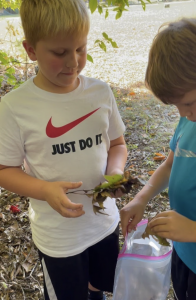
It’s autumn, the colorful leaves are falling in the outdoor classroom, and 2nd graders need practice with skip counting, flexible addition/subtraction strategies, and using models to show their work. I had noticed that the concept of 100 was not yet solid. Students were using millions and thousands to describe much smaller amounts. To address their math needs, along with their desire to be in nature, we visited our outdoor classroom to gather 100 leaves in three minutes. The students were paired and had drawn out their strategy before going outside. Counting one by one was NOT an option. Their strategies included:
- stacking leaves in piles of 10
- each child counting out 50 leaves by skip counting
- counting out the first 10 and estimating the other nine 10s
<p”>After the first trial, the results were: 8, 18, 25, 51, and 140. A class reflection followed to generate new and improved ideas. As it turns out many pairs had resorted to counting one by one.
<p”>The second time, the students were more efficient and used estimation and skip counting to get closer to 100. One pair conducted a divide-and-conquer approach. They made a group of 10 together by finding two groups of five leaves. Once they had 10, they duplicated that by making a pile that appeared to be the same height.
The results were much closer the 2nd time:
82, 91, 94, 97, 100* (* there may have been some leaves added at the end, but they were certainly close to 100).
Laura Waite, Otisfield Community School, Grade 2
Windows and Wondering
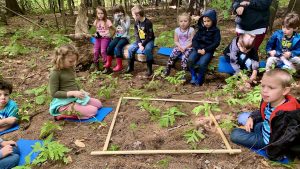
Oscar Wilde once said, “Two men look out a window. One sees mud, the other sees the stars.” What do you think a class of curious Kindergarteners sees when they look through a window in the woods? Can you imagine what kinds of math opportunities a window can provide?
I put 4 meter sticks down on the ground in our classroom space in the woods. I asked my students, “What do you notice? What do you wonder?” The first time I did this with my class, their responses were very hesitant. “Um pine needles and leaves?” “Why is there a stick in there?” We tried the activity a few more times and each time we got better at noticing and wondering. A week ago, I did it again and I heard more excitement, engagement, and vocabulary use. “I noticed that there are some leaves that have many different colors!” “I noticed there is a footprint in the corner. I wonder what made it!”
After we notice and wonder as much as we can, I ask them to think of some math questions we could ask. This activity has led us to counting leaves, estimating how many pine needles were inside the window, and measuring the length of a footprint with acorns. By laying down a clear visual that represents a window, the math opportunities are as endless as students’ wondering will take you. This activity can be easily used by students of all ages, grades, and abilities. Each age group will approach it at the level where they are, so the maths may be as simple or as complicated as would be appropriate for the ages. Changing window size and adding inside grid work is a great way to keep the activity fresh. Putting the window down in unique and different areas is also a great way to keep students wondering.
We love this activity because it lets us look closer, to wonder and to hear what others are also wondering, and to find math where we just played. It might be mud, it might be stars, but either way we are happily mathing!
Maggie Corlett, Kindergarten, Meroby Elementary, Mexico, ME
Contact Us | Programs | Professional Learning | Privacy Policy
Copyright © 1992 — 2020 Maine Mathematics and Science Alliance • All rights reserved
207.626.3230
219 Capitol Street, Suite 3 Augusta, Maine 04330


